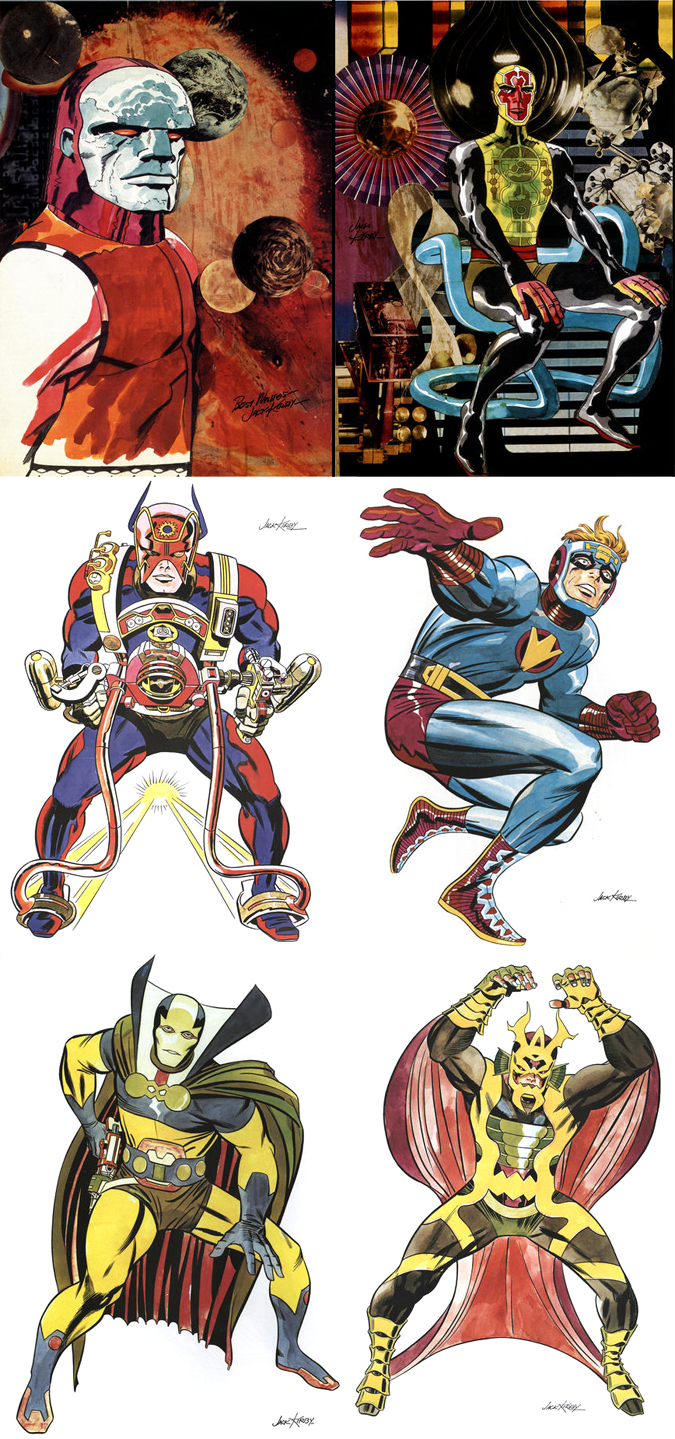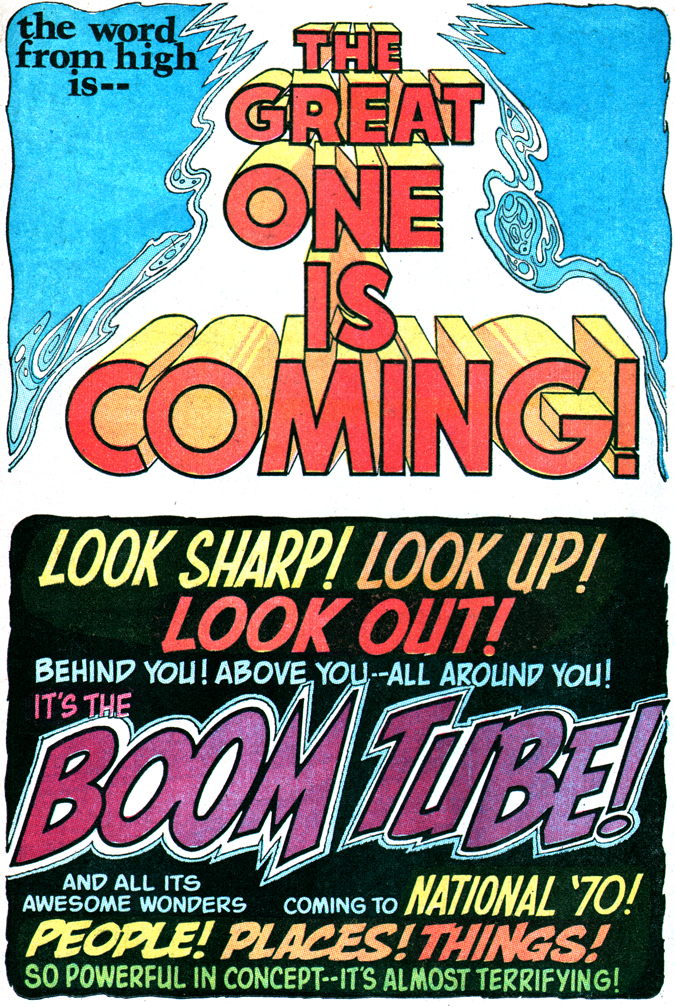[Just to keep up the context, here courtesy of the Kirby Museum archives (and John Morrows’ wicked awesome mag, The Jack Kirby Collector, from whence they were scanned) are the concept drawings Jack used for his presentation to DC Comics in 1970, depicting characters in his Fourth World pitch. Top row: Darkseid (left) and Metron on his Mobius Chair (right); inks by Jack Kirby. Second row: Orion (left) and Lightray (right); inks by Don Heck. Third row: Mister Miracle (left) and Mantis (right); inks by Don Heck.]
Category Archives: Where Fourth Art Thou? Essays
Where Fourth Art Thou? Part Two
Part Two: In the Beginning…
The story so far: Jack “The King” Kirby is dissatisfied with his arrangement at Marvel Comics and, negotiations having failed, signs up with rival DC Comics (a.k.a., National Periodical Publications). Let’s now join our story already in progress:
The bombshell news of Jack’s “defection,” as big a story in comics publishing as there ever was, hits the street in March, 1970. His intention at the House of Superman is to establish a DC Comics West, with Jack serving primarily as a sort of California editorial director of the outfit, writing and drawing a title or two, but mostly launching ideas into the hands of creative teams. Kirby’s idea is to initially launch three titles that encompass a “New Gods Trilogy” — The Forever People, Orion, and Mister Miracle — a wide-canvassed, interlocking epic to run over many, many issues of said comics, which he hopes, down the road, to be trimmed and edited into a huge graphic novel (to use modern parlance). Obviously, Jack’s concepts regarding comics publishing are as far-ranging as his imagination for the stories themselves: The King envisioned over-sized comics, magazine-sized comics, hardcover comics…
Carmine Infantino had been known much of his career at DC as the quintessential artist on The Flash and on “Adam Strange.” His art style was not unlike Kirby’s in some ways — it was kinetic, always in motion, well-designed and vibrant — and you can sense in the work a passion for the sleek and the modern, epitomized by his futuristic cityscapes in Mystery in Space and exploits of the Scarlet Speedster. When DC Comics, flush with Batman TV show merchandising money and buyer Kinney National Services’ hunger for “leisure time” industries, was sold, big editorial shake-ups were already in progress at the Lexington Avenue offices. The artist (“Enfant Rouge” was his self-styled nickname) was not only supremely talented, he was also ambitious to establish himself on the business side of things.
Carmine became close with Irwin Donenfeld, son of one of the publishers and a manager, and together they started planning for the future. Comics sales, despite the 1966-67 Batman bump, were plummeting (for whatever reason — Competition from TV? Shrinking newsstand distribution? The exodus of female readers?), needed a powerful jolt after the Era of Camp: A New Age of Relevancy. Whether by design or accident, Carmine hit upon a “daring and different” concept: Installing a new regime of “Artist as Editor.” In short order, a swath of the old-time editors either met with retirement, health issues, office intrigue or even death, and some of the field’s finest artists, each with tremendous storytelling ability, came on board as the new editorial staff. Among them were Joe Kubert, Mike Sekowsky, Dick Giordano (top-shelf talent recruited from bottom-tier Charlton Comics), and Joe Orlando (ex-Mad man, with whom Carmine had an especially tight bond), and they individually brought a refreshing graphic sensibility to the books (and Ye Blogger’s favorite era in DC Comics’ history, if you care to note). Suddenly double-page spreads opened invigorating and dynamic stories, and new, resonant and exciting characters abounded. Titles were revamped, staid characters re-invented for modern times… (Of course, some of the preceding events overlapped, but in general this was the case.) Young writers and artists were increasing allowed in to contribute, particularly Neal Adams (whose arrival predates the upheaval a bit, but the superb creator seized the opportunity to virtually reinvent the super-hero comic book), Marv Wolfman, Len Wein, and three of “The Studio” quartet, Berni Wrightson, Michael W. Kaluta and Jeffrey Jones. Veteran artists saw new freedom and hit the ground running, especially Gil Kane and Russ Heath, among others. It was, at least to this kid, a golden age…
Anyway, DC Comics’ new owner, Steve Ross of Kinney National Services/Warner 7 Arts, had confidence in giving his managers wide freedom to run their divisions. He thrived on his “people” skills and a refreshing hands-off attitude came from on-high. Carmine was intent to show the Big Guys that he had what it could take…
So, naturally, considering Jack Kirby was responsible for co-creating a vast majority of upstart Marvel Comics’ “universe” of characters and concepts, Carmine’s acquisition of The King’s services must have appeared quite the feather in the editorial director’s cap. (Note, too, that in 1968, Marvel had finally broke free of the yoke of Independent News, the distributor of Martin Goodman’s line, which was owned by the Distinguished Competition — DC to you and me — after being acquired by Perfect Film and joining up with Curtis Circulation Company to get on the nation’s newsstands. Marvel was flooding the market, finally free of the eight-titles-a-month limit imposed by IND, and was snapping at DC’s standing as industry leader. The game, as the good detective said, was afoot.)
Jack Kirby’s grand scheme to revitalize the comics marketplace — with new formats and an entire line of new books and magazines — was reined in by DC’s bean-counters. It was settled in New York that The King would write and draw the three inter-connected titles, plus take on an existing DC comic, which was Superman’s Pal, Jimmy Olsen. But you knew that already…
Where Fourth Art Thou? Part One
Part One: Lo, There Shall Be An Ending
[Embarking on this year-long adventure (fingers crossed!), perhaps it’s proper to set the right context and explain, as best I understand, just what is Jack Kirby’s Fourth World and from whence it came. And just like the full-color funny papers of yore once made each Sunday a special day of the week for the lovers of four-color adventure, yours truly is planning a special Fourth World-related essay every Sunday as an added bonus… — JBC]
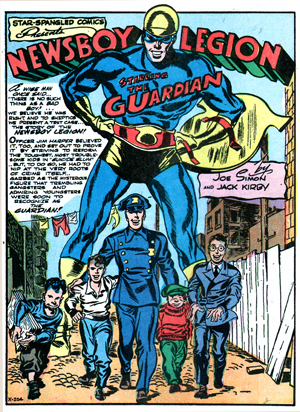 By 1970, Jack Kirby was truly the King of American comic book artists. In the early 1940s, with longtime partner Joe Simon (notably an artist, writer, and editor), Jack had struck gold for Timely Comics with the creation of Captain America, an immediate sensation with kids, and the strip was renowned for its kinetic violence, explosive action and no-holds-barred anti-Nazi sentiment. Unable to get a deal more to their liking at Timely (where they also created the kid gang sub-genre of super-hero comics), Simon & Kirby, a byline increasingly recognized by a growing legion of fans, moved over to top-shelf DC Comics, where they produced innumerable comics (significantly “The Newsboy Legion Starring The Guardian”). After World War II, the team would create the singularly most successful genre in the business, romance comics, but by the mid-’50s, Joe and Jack would break up the most successful creative team in the form’s history when the comics industry bottomed-out. Now solo, Jack rejoined Timely, re-christened Marvel Comics, and with the imprint’s editor and main writer Stan Lee (and important work by Steve Ditko), the duo (arguably to become the second most successful pairing) would go on to create what is today called the Marvel Universe, including the Fantastic Four, Incredible Hulk, Thor, Iron Man, and a resurrected Captain America, among many, many other characters. Super-hero comics would experience a renaissance during Stan the Man and King Kirby’s reign over the “Marvel Age.”
By 1970, Jack Kirby was truly the King of American comic book artists. In the early 1940s, with longtime partner Joe Simon (notably an artist, writer, and editor), Jack had struck gold for Timely Comics with the creation of Captain America, an immediate sensation with kids, and the strip was renowned for its kinetic violence, explosive action and no-holds-barred anti-Nazi sentiment. Unable to get a deal more to their liking at Timely (where they also created the kid gang sub-genre of super-hero comics), Simon & Kirby, a byline increasingly recognized by a growing legion of fans, moved over to top-shelf DC Comics, where they produced innumerable comics (significantly “The Newsboy Legion Starring The Guardian”). After World War II, the team would create the singularly most successful genre in the business, romance comics, but by the mid-’50s, Joe and Jack would break up the most successful creative team in the form’s history when the comics industry bottomed-out. Now solo, Jack rejoined Timely, re-christened Marvel Comics, and with the imprint’s editor and main writer Stan Lee (and important work by Steve Ditko), the duo (arguably to become the second most successful pairing) would go on to create what is today called the Marvel Universe, including the Fantastic Four, Incredible Hulk, Thor, Iron Man, and a resurrected Captain America, among many, many other characters. Super-hero comics would experience a renaissance during Stan the Man and King Kirby’s reign over the “Marvel Age.”
It is now part of Kirbyhead lore that Jack, after having created some of the most exciting and resonant super-hero adventures in comics, was becoming increasing dissatisfied with his standing at Marvel by the late ’60s. Though it is said he received one of the highest page rates at the House of Ideas, Jack was still just work-for-hire, on one hand creating the very cast and canvas that was attracting an ever-growing readership, on the other, not sharing in ownership of the profit engine. It’s important to note, too, the artist/writer (the King plotted most of the stories he drew, with Stan scribing the captions and dialogue from Jack’s margin notes — later dubbed “the Marvel Style” of comics production) was becoming frustrated with the creative end of things, as well.
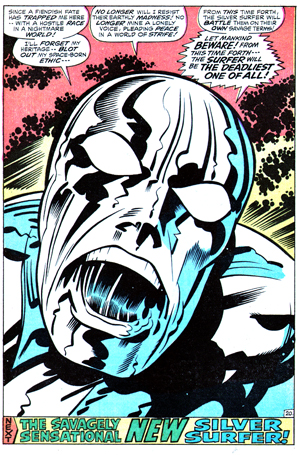 First, there’s the Silver Surfer, whom Jack offhandedly created as the herald of Galactus in Fantastic Four. An immediate sensation, Jack envisioned the character as a sort of “Fallen Angel,” a Lucifer losing favor with God (Galactus) and exiled to Hell (Earth?), with the surfboard-riding space traveler perhaps more a threat to, rather than protector of, our green and blue orb. But Stan saw the former Norrin Rad as a “Wandering Jew,” endlessly travailing our planet alone, seeking answers to cosmic questions — another young person in the search of self in an age of new discovery. (Whose concept is the more commercial? Probably Stan’s, but Jack’s certainly had enormous potential for some complex and stimulating storylines.)
First, there’s the Silver Surfer, whom Jack offhandedly created as the herald of Galactus in Fantastic Four. An immediate sensation, Jack envisioned the character as a sort of “Fallen Angel,” a Lucifer losing favor with God (Galactus) and exiled to Hell (Earth?), with the surfboard-riding space traveler perhaps more a threat to, rather than protector of, our green and blue orb. But Stan saw the former Norrin Rad as a “Wandering Jew,” endlessly travailing our planet alone, seeking answers to cosmic questions — another young person in the search of self in an age of new discovery. (Whose concept is the more commercial? Probably Stan’s, but Jack’s certainly had enormous potential for some complex and stimulating storylines.)
Thus, when Stan kept the news from Jack that Marvel was developing a new title — giant-size for 25¢, at that! — and assigned Silver Surfer art chores to the more artistically slick John Buscema (who had picked up and adapted the Kirby approach to bombastic action under orders from Marvel’s editor), and Jack saw the finished result, it must have been crushing. The origin story in SS #1 depicted the character as a love-lorn and self-pitying lost soul, seeking contact with earth folks and yet always running off (“Shane! Come back, Shane!”).
(For a taste of what might have been, refer to Silver Surfer #18, cover dated Sept. 1970, where Jack’s plot had the former Galactus herald on the advent of an anti-human rampage, a devil on a flying long board (if you will) raging at the world, “Let mankind beware! From this time forth — the Surfer will be the deadliest one of all!” Alas, though the last-page blurb trumpeted, “Next: The savagely sensational new Silver Surfer!” the promised revamping was not to be, as this would be the final issue in the character’s initial run.)
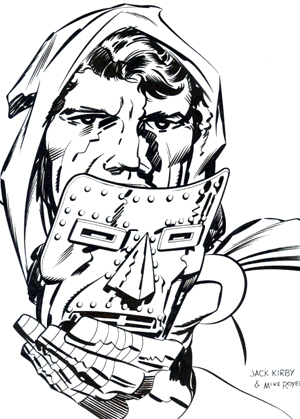 Second, there’s Doctor Doom, Fantastic Four arch-nemesis, conceived in Jack’s eyes as a pathological narcissist, whose depths of selfishness would have the planet scorched to satiate his vanity. Jack’s concept was to have Victor Von Doom, the FF’s Reed Richards college-era roommate, a brilliant and gorgeous Latverian exchange student, suffer an apparently minor accident during a science experiment gone awry. A chemical explosion was to cause a tiny facial scratch (and deteriorating mental stability perhaps), an infinitesimally small marring of his otherwise perfect cheek. That slightest of imperfections would have Von Doom dilusionally believe he was scarred beyond belief and, loathing the image in the mirror, have him going to such extremes as to meld a red-hot iron mask on his face to permanently cover his flaw, hide his shame. This psychological make-up for the villain was a brilliant take, giving us the root and extent of his madness, telling of a subsequent hatred and envy for all things beautiful. Alas, a more melodramatic, hackneyed backstory was written by Stan the Man, having the future European monarch suffer massive facial damage, a face now worth hiding, instead. (Stan did subscribe to the raison d’etre for the bad doctor’s despising of the super-hero quartet, as Von Doom unfairly blamed young Reed Richards for the fateful disaster.)
Second, there’s Doctor Doom, Fantastic Four arch-nemesis, conceived in Jack’s eyes as a pathological narcissist, whose depths of selfishness would have the planet scorched to satiate his vanity. Jack’s concept was to have Victor Von Doom, the FF’s Reed Richards college-era roommate, a brilliant and gorgeous Latverian exchange student, suffer an apparently minor accident during a science experiment gone awry. A chemical explosion was to cause a tiny facial scratch (and deteriorating mental stability perhaps), an infinitesimally small marring of his otherwise perfect cheek. That slightest of imperfections would have Von Doom dilusionally believe he was scarred beyond belief and, loathing the image in the mirror, have him going to such extremes as to meld a red-hot iron mask on his face to permanently cover his flaw, hide his shame. This psychological make-up for the villain was a brilliant take, giving us the root and extent of his madness, telling of a subsequent hatred and envy for all things beautiful. Alas, a more melodramatic, hackneyed backstory was written by Stan the Man, having the future European monarch suffer massive facial damage, a face now worth hiding, instead. (Stan did subscribe to the raison d’etre for the bad doctor’s despising of the super-hero quartet, as Von Doom unfairly blamed young Reed Richards for the fateful disaster.)
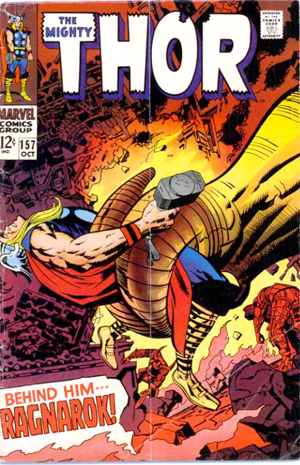 Thirdly, and most relevant to this ongoing examination of his Fourth World, Jack had imagined a radical idea: In the pages of The Mighty Thor, completely eradicate the pantheon of Asgardian gods (as prophesied in ancient Norse mythology, on which Jack’s Thunder God & Company’s adventures had sprung), by bringing on Ragnarok, the twilight of the old gods, the end of Asgard, the death of the immortals, the arrival of the Valkyries to take the dead Viking warriors to their final rest in Valhalla… The Kirby innovation, besides exterminating a whole crew of characters that presumably made some shekels for Marvel, was to have new gods arise from the aftermath of the apocalyptic conflict, a new cast of celestial beings, not speaking in faux Shakespearean thee’s and thou’s as did Odin and his ilk, but rather super-beings rooted in modern-day, relevant concepts (the threats to our natural environment, the rise of malevolent technology — Life versus Anti-Life, as such) concerning us little folk. Needless to say, Stan passed on Jack’s reconception, preferring to keep Goldilocks as is, and consistently reviving (but never fulfilling) the teasing threat of Nordic Armageddon over the title’s span.
Thirdly, and most relevant to this ongoing examination of his Fourth World, Jack had imagined a radical idea: In the pages of The Mighty Thor, completely eradicate the pantheon of Asgardian gods (as prophesied in ancient Norse mythology, on which Jack’s Thunder God & Company’s adventures had sprung), by bringing on Ragnarok, the twilight of the old gods, the end of Asgard, the death of the immortals, the arrival of the Valkyries to take the dead Viking warriors to their final rest in Valhalla… The Kirby innovation, besides exterminating a whole crew of characters that presumably made some shekels for Marvel, was to have new gods arise from the aftermath of the apocalyptic conflict, a new cast of celestial beings, not speaking in faux Shakespearean thee’s and thou’s as did Odin and his ilk, but rather super-beings rooted in modern-day, relevant concepts (the threats to our natural environment, the rise of malevolent technology — Life versus Anti-Life, as such) concerning us little folk. Needless to say, Stan passed on Jack’s reconception, preferring to keep Goldilocks as is, and consistently reviving (but never fulfilling) the teasing threat of Nordic Armageddon over the title’s span.
A review of Jack’s late-’60s work reveals his unwillingness to create new characters and concepts for the Marvel imprint after a cosmically fruitful surge of creativity during the decade’s middle years. Between 1965 and ’67, for instance, Jack would introduce in the pages of Fantastic Four the Inhumans, Galactus, the Silver Surfer, the one-issue masterpiece “This Man, This Monster,” the Black Panther, the Kree empire, and “Him,” who would later evolve into Adam Warlock. Thereafter, while still plotting and drawing vibrant and engaging adventures, it seemed Jack was reticent to continue producing original stories and guest-stars for the publisher.
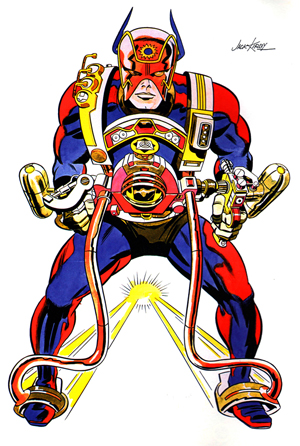 Future investigation would reveal that, far from fermenting new ideas in his awesome (Kirby-sized!) imagination, Jack was privately conceiving of a new line of concepts and characters, musings he began with his End-of-Asgard notion, in titles he would helm as writer and editor, as well as artist. By 1969, while still plotting and penciling for Marvel (and receiving increasingly frustrating creative interference from the editor), Jack was secretly negotiating with DC Comics, the industry leader nervously watching the House of Idea’s ascent in the volatile marketplace of American comics. (By the mid-’70s, Marvel would, indeed, surpass DC as the number one comics publisher.) The artist met with Carmine Infantino, creative head (and soon-to-be publisher) of DC, and the King gave “Rouge Enfant” a full-blown presentation, which the editorial director approved. Contracts were signed, notice was given, and Jack Kirby was poised to start on perhaps the most creatively important chapter of his remarkable career.
Future investigation would reveal that, far from fermenting new ideas in his awesome (Kirby-sized!) imagination, Jack was privately conceiving of a new line of concepts and characters, musings he began with his End-of-Asgard notion, in titles he would helm as writer and editor, as well as artist. By 1969, while still plotting and penciling for Marvel (and receiving increasingly frustrating creative interference from the editor), Jack was secretly negotiating with DC Comics, the industry leader nervously watching the House of Idea’s ascent in the volatile marketplace of American comics. (By the mid-’70s, Marvel would, indeed, surpass DC as the number one comics publisher.) The artist met with Carmine Infantino, creative head (and soon-to-be publisher) of DC, and the King gave “Rouge Enfant” a full-blown presentation, which the editorial director approved. Contracts were signed, notice was given, and Jack Kirby was poised to start on perhaps the most creatively important chapter of his remarkable career.


